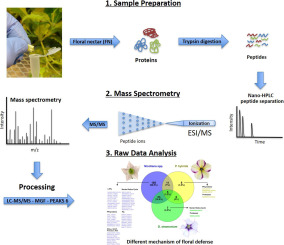当前位置:
X-MOL 学术
›
J. Proteomics
›
论文详情
Our official English website, www.x-mol.net, welcomes your feedback! (Note: you will need to create a separate account there.)
LC-MS/MS based comparative proteomics of floral nectars reveal different mechanisms involved in floral defense of Nicotiana spp., Petunia hybrida and Datura stramonium.
Journal of Proteomics ( IF 3.3 ) Pub Date : 2019-12-14 , DOI: 10.1016/j.jprot.2019.103618 FredyA Silva 1 , Adel Guirgis 2 , Patrick von Aderkas 3 , Christoph H Borchers 4 , Robert Thornburg 1
Journal of Proteomics ( IF 3.3 ) Pub Date : 2019-12-14 , DOI: 10.1016/j.jprot.2019.103618 FredyA Silva 1 , Adel Guirgis 2 , Patrick von Aderkas 3 , Christoph H Borchers 4 , Robert Thornburg 1
Affiliation

|
Tobacco floral nectar (FN) is a biological fluid produced by nectaries composed of sugars, amino acids and proteins called nectarins, involved in the floral defense. FN provides an ideal source of nutrients for microorganisms. Understanding the role of nectar proteins is essential to predict impacts in microbial growth, composition and plants-pollinators interactions. Using LC-MS/MS-based comparative proteomic analysis we identified 22 proteins from P. hybrida, 35 proteins from D. stramonium, and 144 proteins from 23 species of Nicotiana. The data are available at ProteomeXchance (PXD014760). GO analysis and secretory signal prediction demonstrated that defense/stress was the largest group of proteins in the genus Nicotiana. The Nicotiana spp. proteome consisted of 105 exclusive proteins such as lipid transfer proteins (LTPs), Nectar Redox Cycle proteins, proteases inhibitors, and PR-proteins. Analysis by taxonomic sections demonstrated that LTPs were most abundant in Undulatae and Noctiflora, while nectarins were more abundant in Rusticae, Suaveolens, Polydicliae, and Alata sections. Peroxidases (Pox) and chitinases (Chit) were exclusive to P. hybrida, while D. stramonium had only seven unique proteins. Biochemical analysis confirmed these differences. These findings support the hypothesis that, although conserved, there is differential abundance of proteins related to defense/stress which may impact the mechanisms of floral defense. SIGNIFICANCE: This study represents a comparative proteomic analysis of floral nectars of the Nicotiana spp. with two correlated Solanaceous species. Significant differences were identified between the proteome of taxonomic sections providing relevant insights into the group of proteins related to defense/stress associated with Nectar Redox Cycle, antimicrobial proteins and signaling pathways. The activity of FNs proteins is suggested impact the microbial growth. The knowledge about these proteomes provides significant insights into the diversity of proteins secreted in the nectars and the array of mechanisms used by Nicotiana spp. in its floral defense.
中文翻译:

基于LC-MS / MS的花蜜比较蛋白质组学揭示了烟草,矮牵牛和曼陀罗的花防御的不同机制。
烟草花蜜(FN)是一种由糖,氨基酸和称为油桃的蛋白质组成的蜜腺所产生的一种生物流体,它参与了花卉的防御。FN为微生物提供了理想的营养来源。了解花蜜蛋白的作用对于预测微生物生长,成分和植物与传粉媒介相互作用的影响至关重要。使用基于LC-MS / MS的比较蛋白质组学分析,我们鉴定了来自假单胞菌的22种蛋白质,地衣藻的35种蛋白质和来自23种烟草的144种蛋白质。数据可从ProteomeXchance(PXD014760)获得。GO分析和分泌信号预测表明,防御/应激是烟草属中最大的一组蛋白质。烟草属 蛋白质组由105种排他蛋白组成,例如脂质转移蛋白(LTP),花蜜氧化还原循环蛋白,蛋白酶抑制剂和PR蛋白。通过分类学部分的分析表明,LTPs在Undulatae和Noctiflora中最丰富,而油桃在Rusticae,Suaveolens,Polydicliae和Alata部分中更丰富。过氧化物酶(Pox)和几丁质酶(Chit)是杂种毕赤酵母(P. hybrida)独有的,而D. stramonium只有7种独特的蛋白质。生化分析证实了这些差异。这些发现支持以下假设:尽管保守,但与防御/胁迫相关的蛋白质差异丰富,可能影响花卉防御的机制。意义:该研究代表了烟草属花蜜的蛋白质组学比较分析。与两个相关的茄科物种。在分类学部分的蛋白质组之间发现了显着差异,从而提供了与与花蜜氧化还原循环相关的防御/应激相关的蛋白质,抗菌蛋白和信号传导途径相关的蛋白质组的相关见解。提示FNs蛋白的活性会影响微生物的生长。有关这些蛋白质组的知识为了解花蜜中分泌的蛋白质的多样性以及烟草属所使用的一系列机制提供了重要的见识。在其花卉防御中。有关这些蛋白质组的知识为了解花蜜中分泌的蛋白质的多样性以及烟草属所使用的一系列机制提供了重要的见识。在其花卉防御中。有关这些蛋白质组的知识为了解花蜜中分泌的蛋白质的多样性以及烟草属所使用的一系列机制提供了重要的见识。在其花卉防御中。
更新日期:2019-12-17
中文翻译:

基于LC-MS / MS的花蜜比较蛋白质组学揭示了烟草,矮牵牛和曼陀罗的花防御的不同机制。
烟草花蜜(FN)是一种由糖,氨基酸和称为油桃的蛋白质组成的蜜腺所产生的一种生物流体,它参与了花卉的防御。FN为微生物提供了理想的营养来源。了解花蜜蛋白的作用对于预测微生物生长,成分和植物与传粉媒介相互作用的影响至关重要。使用基于LC-MS / MS的比较蛋白质组学分析,我们鉴定了来自假单胞菌的22种蛋白质,地衣藻的35种蛋白质和来自23种烟草的144种蛋白质。数据可从ProteomeXchance(PXD014760)获得。GO分析和分泌信号预测表明,防御/应激是烟草属中最大的一组蛋白质。烟草属 蛋白质组由105种排他蛋白组成,例如脂质转移蛋白(LTP),花蜜氧化还原循环蛋白,蛋白酶抑制剂和PR蛋白。通过分类学部分的分析表明,LTPs在Undulatae和Noctiflora中最丰富,而油桃在Rusticae,Suaveolens,Polydicliae和Alata部分中更丰富。过氧化物酶(Pox)和几丁质酶(Chit)是杂种毕赤酵母(P. hybrida)独有的,而D. stramonium只有7种独特的蛋白质。生化分析证实了这些差异。这些发现支持以下假设:尽管保守,但与防御/胁迫相关的蛋白质差异丰富,可能影响花卉防御的机制。意义:该研究代表了烟草属花蜜的蛋白质组学比较分析。与两个相关的茄科物种。在分类学部分的蛋白质组之间发现了显着差异,从而提供了与与花蜜氧化还原循环相关的防御/应激相关的蛋白质,抗菌蛋白和信号传导途径相关的蛋白质组的相关见解。提示FNs蛋白的活性会影响微生物的生长。有关这些蛋白质组的知识为了解花蜜中分泌的蛋白质的多样性以及烟草属所使用的一系列机制提供了重要的见识。在其花卉防御中。有关这些蛋白质组的知识为了解花蜜中分泌的蛋白质的多样性以及烟草属所使用的一系列机制提供了重要的见识。在其花卉防御中。有关这些蛋白质组的知识为了解花蜜中分泌的蛋白质的多样性以及烟草属所使用的一系列机制提供了重要的见识。在其花卉防御中。


























 京公网安备 11010802027423号
京公网安备 11010802027423号